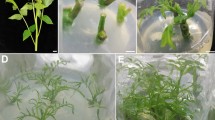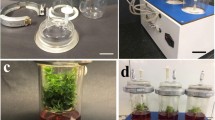Abstract
An efficient propagation system of pitaya with diverse genetic background was established by using tender stem as explants. Various types of plant growth regulators (PGRs) were used to determine the most effective hormone combination for shoot proliferation. Zeatin (ZT), thidiazuron (TDZ), 2, 4-dichlorophenoxyacetic acid (2, 4-D) and 6-benzylaminopurine (6-BA) alone could induce multiple shoots. In that case, the most shoots per explant i.e. 4.6 (13.68 µM ZT), 4.8 (0.11 µM TDZ), 4.3 (17.76 µM 6-BA) and 3.2 (0.23 µM 2, 4-D) were obtained. The best PGRs combination was MS medium with 3.0 µM ZT and 0.5 µM IBA producing the most shoots per explant and the most vigorous shoots. Of the two varieties and six superior selections cultured on the best PGRs combination, more than 6.0 shoots per explant were obtained. No polymorphism was detected among in vitro-derived plantlets selected at random after 11 sub-cultures. Those results showed that MS media with 13.68 µM ZT and 2.46 µM IBA was suitable for shoot propagation of diverse pitaya varieties and selections. The protocol can be used for large-scale propagation of pitaya to meet the demand of increasing commercial cultivation.


Similar content being viewed by others
References
Agarwal T, Gupta AK, Patel AK, Shekhawat NS. (2014) Micropropagation and validation of genetic homogeneity of Alhagi maurorum using SCoT, ISSR and RAPD markers. Plant Cell Tissue Org Cult doi:10.1007/s11240-014-0608-z
Cavalcante ÍHL, Martins ABG (2008) Effect of juvenility on cutting propagation of red pitaya. Fruits 63(5):277–283
Drew RA, Azimi M (2002) Micropropagation of red pitaya (Hylocereus undatus). Acta Hort 575:93–98
Ellis DD, Barczynska H, McCown BH, Nelson N (1991) A comparison of BA, zeatin and thidiazuron for adventitious bud formation from Picea glauca embryos and epicotyl explants. Plant Cell Tissue Org Cult 27:281–287
Elobeidy AA (2006) Mass propagation of pitaya (dragon fruit). Fruits 61(5):313–319
Esquivel P, Stintzing FC, Carle R (2007) Comparison of morphological and chemical fruit traits from different pitaya genotypes (Hylocereus sp.) grown in Costa Rica. J Appl Bot Food Qual 81(1):7–14
Fan QJ, Zheng SC, Yan FX, Zhang BX, Qiao G, Wen XP (2013) Efficient regeneration of dragon fruit (Hylocereus undatus) and an assessment of the genetic fidelity of in vitro: derived plants using ISSR markers. J Hortic Sci Biotechnol 88(5):631–637
Harivaindaran KV, Rebecca OPS, Chandran S (2008) Study of optimal temperature, pH and stability of dragon fruit (Hylocereus polyrhizus) peel for use as potential natural colorant. Pak J Biol Sci 11(18):2259–2263
Huetteman CA, Preece JE (1993) Thidiazuron: a potent cytokinin for woody plant tissue culture. Plant Cell Tissue Org Cult 33(2):105–119
Infante R (1992) In vitro axillary shoot proliferation and somatic embryogenesis of yellow pitaya Mediocactus coccineus (Salm-Dyck). Plant Cell Tissue Org Cult 31:155–159
Le Bellec F, Vaillant F, Imbert E (2006) Pitahaya (Hylocereus spp.): a new fruit crop, a market with a future. Fruits 61(4):237–250
Liaotrakoon W (2013a) Characterization of dragon fruit (Hylocereus spp.) components with valorization potential. Dissertation for Ph.D. Faculty of Bioscience Engineering, Ghent University
Liaotrakoon W, De Clercq N, Van Hoed V, Dewettinck K (2013b) Dragon fruit (Hylocereus spp.) seed oils: their characterization and stability under storage conditions. J Am Oil Chem Soc 90(2): 207–215
Mizrahi Y, Nerd A (1999) Climbing and columnar cacti: new arid land fruit crops. In: Janick J (ed) Perspectives on new crops and new uses. ASHS Press, Alexandria, pp 358–366
Mohamed-Yasseen Y (2002) Micropropagation of pitaya (Hylocereus undatus Britton et rose). Vitro Cell Dev Biol-Plant 38(5):427–429
Murashige T, Skoog F (1962) A revised medium for rapid growth and bioassays with tobacco cultures. Physiol Plant 15:473–497
Nurliyana R, Syed Zahir I, Mustapha Suleiman K, Aisyah MR, Kamarul Rahim K (2010) Antioxidant study of pulps and peels of dragon fruits: a comparative study. Int Food Res J 17:367–375
Ortiz-Hernández YD, Carrillo-Salazar JA (2012) Pitahaya (Hylocereus spp.): a short review. Comunicata Scientiae 3(4):220–237
Pelah D, Kaushik RA, Mizrahi Y, Sitrit Y (2002) Organogenesis in the vine cactus Selenicereus megalanthus using thidiazuron. Plant Cell Tissue Org Cult 71:81–84
Rathore NS, Rai MK, Phulwaria M, Rathore N, Shekhawat NS (2014) Genetic stability in micropropagated Cleome gynandra revealed by SCoT analysis. Acta Physiol Plant 36(2):555–559
Stintzing FC, Carle R (2007) Betalains–emerging prospects for food scientists. Trends Food Sci Technol 18(10):514–525
Viñas M, Fernández-Brenes M, Azofeifa A, Jiménez VM (2012) In vitro propagation of purple pitahaya (Hylocereus costaricensis [F.A.C. Weber] Britton & Rose) cv. Cebra. In Vitro Cell Dev Biol Plant 48:469–477
Wichienchot S, Jatupornpipat M, Rastell RA (2010) Oligosaccharides of pitaya (dragon fruit) flesh and their prebiotic properties. Food Chem 120(3):850–857
Xia L, Qin YH, Liu CM, Hu GB (2014) Establishment and application of SCoT-PCR system for litchi. Chinese Agric Sci Bull 30(13):147–156
Acknowledgments
This work was supported by Science and Technology Planning Project of Guangzhou (2014Y2-00164); Agricultural Technology Extension Project of Guangdong Province (5300-F13085); Key Laboratory of Innovation and Utilization for Germplasm Resources in Horticultural Crops in South China of Guangdong Higher Education Institutes, South China Agricultural University (SCAU) (KBL11008); Key Laboratory of Biology and Genetic Improvement of Horticultural Crops, South China of Ministry of Agriculture, College of Horticulture, SCAU.
Author information
Authors and Affiliations
Corresponding authors
Additional information
Qing-zhu Hua, Pengkun Chen and Wanqing Liu have contributed equally to this work.
Electronic supplementary material
Below is the link to the electronic supplementary material.
Rights and permissions
About this article
Cite this article
Hua, Q., Chen, P., Liu, W. et al. A protocol for rapid in vitro propagation of genetically diverse pitaya. Plant Cell Tiss Organ Cult 120, 741–745 (2015). https://doi.org/10.1007/s11240-014-0643-9
Received:
Accepted:
Published:
Issue Date:
DOI: https://doi.org/10.1007/s11240-014-0643-9




